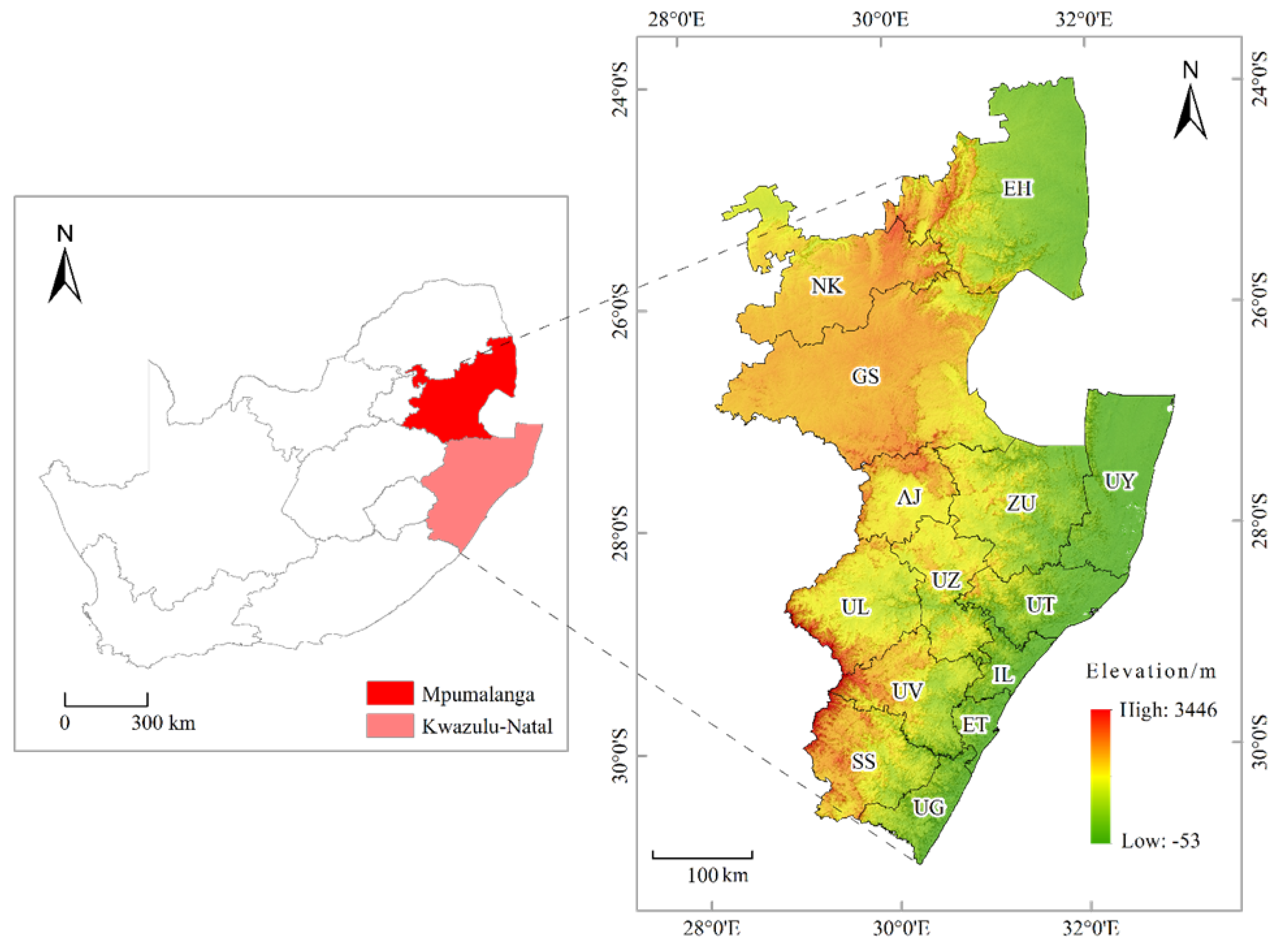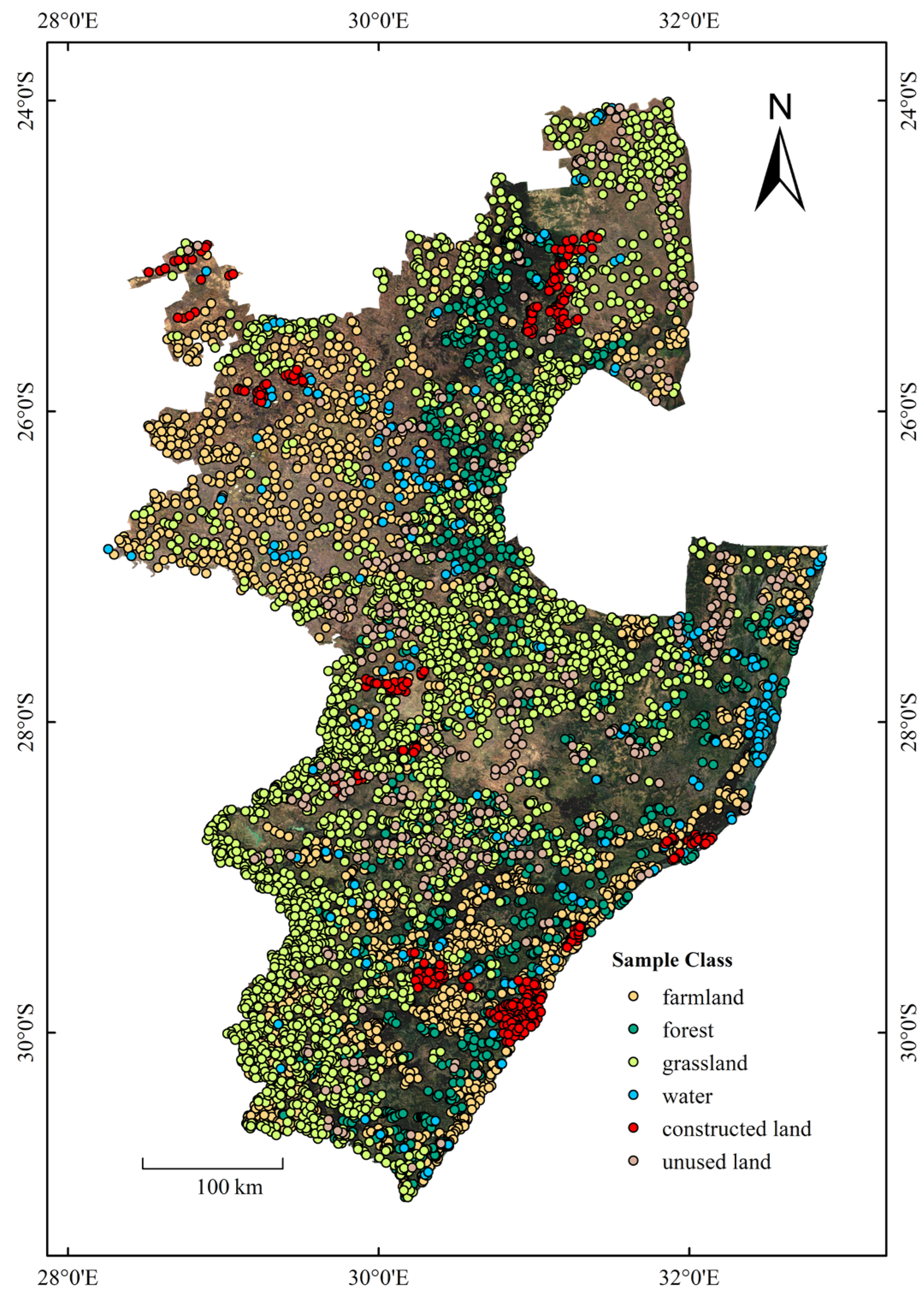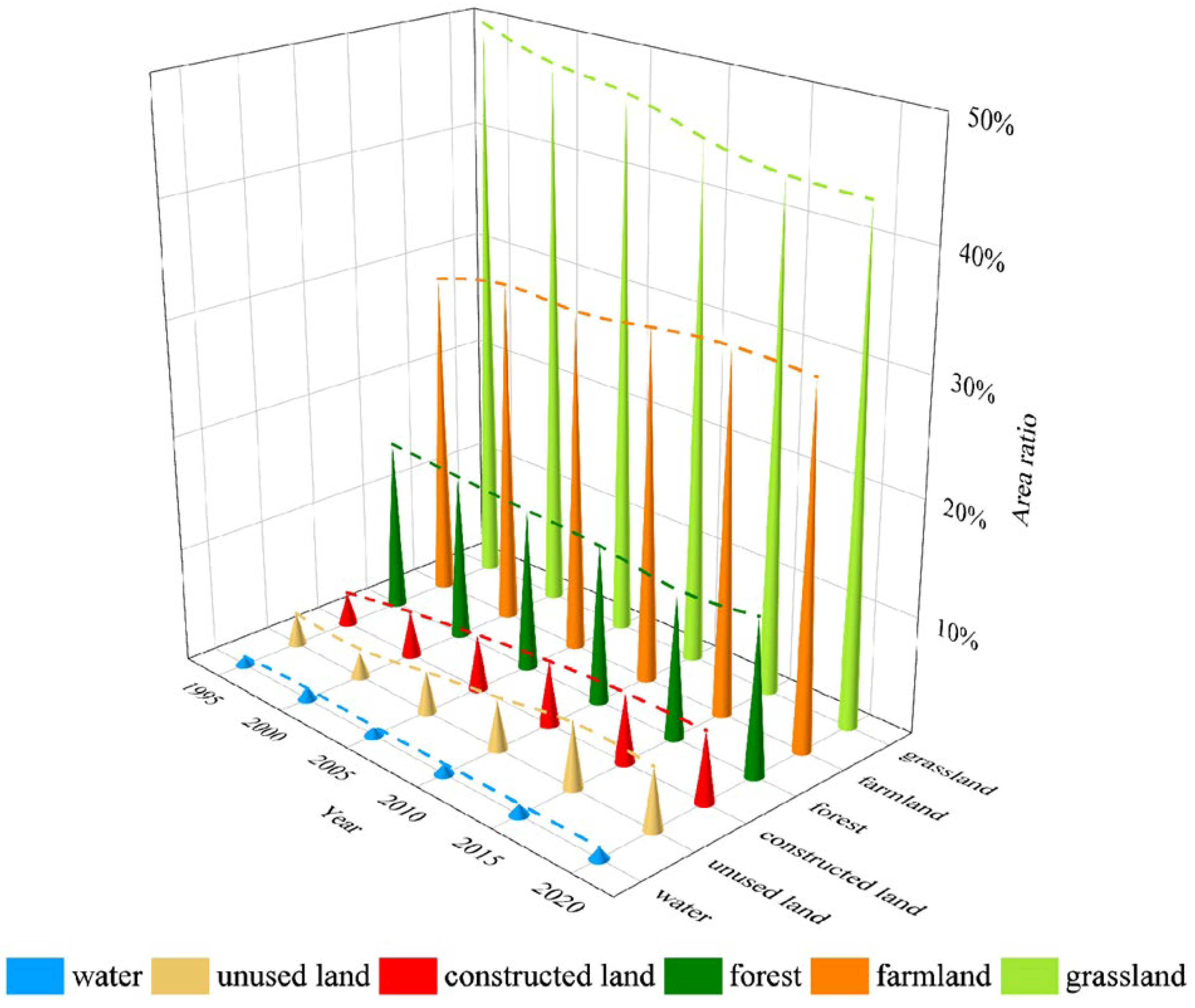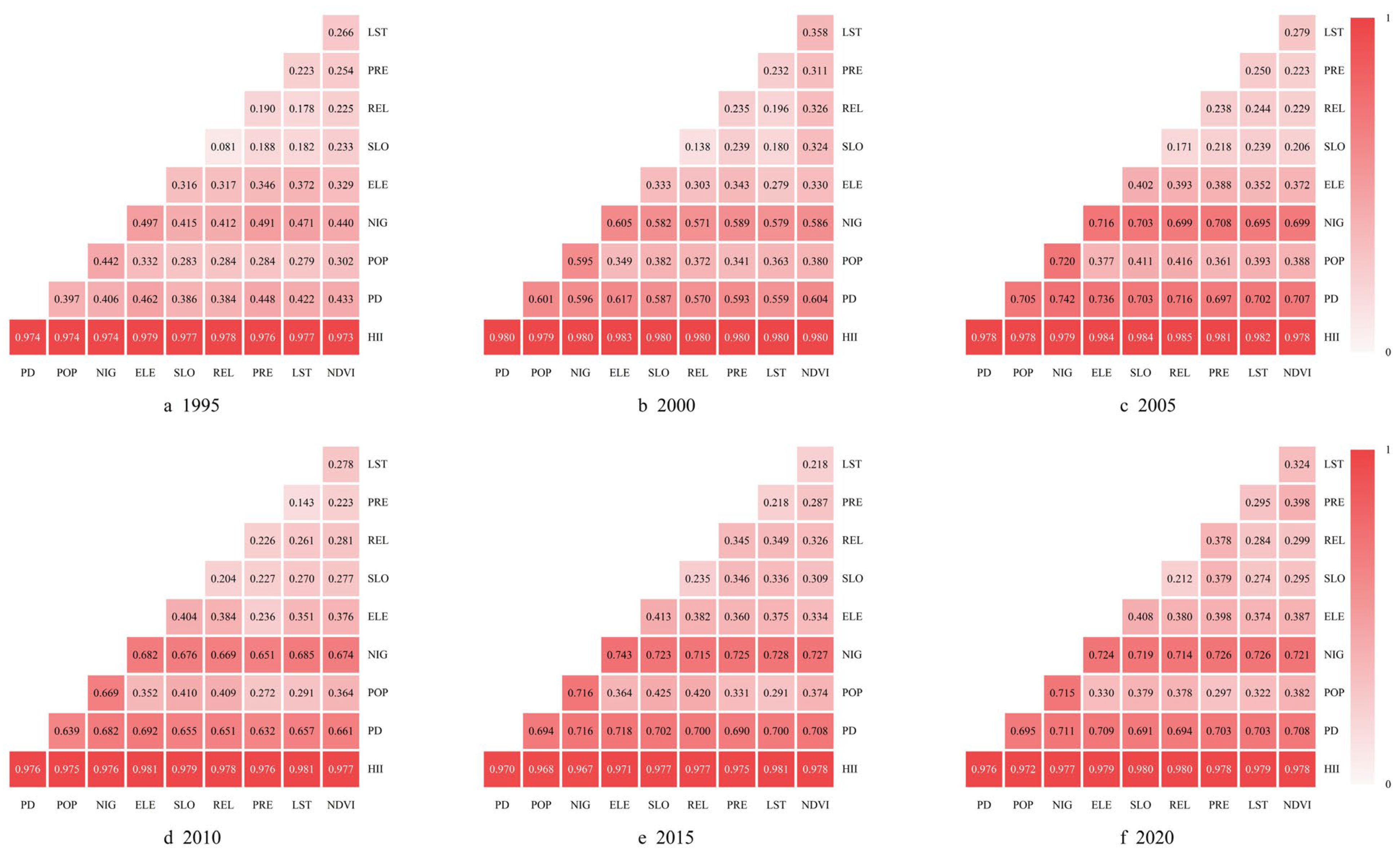Analysis of Land Use/Cover Changes and Driving Forces in a Typical Subtropical Region of South Africa
Abstract
:1. Introduction
2. Study Area and Data
2.1. Study Area
2.2. Data Sources
3. Methods
3.1. LULC Classification System and Sampling Scheme
- (1)
- LULC classification system: Regional LULC can be divided based on various classification systems, depending on the application objectives. For example, the International Geosphere-Biosphere Programme (IGBP) system is particularly comprehensive, offering 17 primary classes that range from various types of forests and shrublands to urban and constructed lands [24]. This system is widely recognized for its utility in remote sensing applications and has been adopted in numerous global and regional studies. Studies centered on agriculture may find the Food and Agriculture Organization (FAO) system more fitting [25]. However, it is crucial to recognize that specific research objectives might require different LULC classification systems. For instance, Ge and colleagues divided land use types into farmland, forest, grassland, garden land, residential and industrial land, transportation land, water, and others in their study [26]. Ju divided the LULC into 31 classes when studying the portrayal of the national land use spatial pattern [27]. Given the objectives and the actual situation of the study area, farmland, forest, grassland, water, constructed land, and unused land were adopted as six primary classes for the classification system in this study.
- (2)
- Sampling scheme: In this study, a proportional stratified random sampling method was employed to select training and testing samples for different LULC classes based on their respective area ratio to the total area of the study area [28]. The sampling process was conducted through the visual interpretation of high-resolution imagery available on the GEE platform. A total of 7000 samples were collected across the study area, as illustrated in Table 2. The distribution of samples varies depending on the research year under consideration. The distribution map of samples collected for 2020 is shown in Figure 2. It is noteworthy that the samples were collected from individual pixels, thereby ensuring a high level of representativeness for each LULC class. The random division of samples into training and testing sets followed a fixed ratio of 5000 to 2000. Specifically, within each class, the division between training and testing sets maintained a fixed ratio of 5:2.
3.2. Feature Combination
3.3. Random Forest Classifier
3.4. Classification Stage
3.4.1. Pixel-Based Classification
3.4.2. Object-Oriented Classification
3.5. Optimal Parameter-Based Geodetector
3.6. Selection of Dependent Variables and Driving Factors
4. Experimental Results
4.1. Accuracy Assessment
4.2. LULCC Analysis
4.3. Driving Force Analysis
4.3.1. Parameter Optimization
4.3.2. Factor Detection
4.3.3. Interaction Detection
5. Discussion
5.1. Comparison of Accuracy Difference of Classification Methods
5.2. Primary Driving Factors of LULCC
5.3. Prospect and Limitation
6. Conclusions
Author Contributions
Funding
Institutional Review Board Statement
Data Availability Statement
Conflicts of Interest
References
- Abraham, A.; Kundapura, S. Spatio-temporal Dynamics of Land Use Land Cover Changes and Future Prediction Using Geospatial Techniques. J. Indian Soc. Remote Sens. 2022, 50, 2175–2191. [Google Scholar] [CrossRef]
- Wang, X.; Bao, Y. Study on the Methods of Land Use Dynamic Change Research. Prog. Geogr. 1999, 1, 83–89. [Google Scholar]
- Hitayezu, P.; Wale, E.; Ortmann, G.F. Assessing Agricultural Land-use Change in the Midlands Region of KwaZulu-Natal, South Africa: Application of Mixed Multinomial Logit. Environ. Dev. Sustain. 2016, 18, 985–1003. [Google Scholar] [CrossRef]
- Coetzer, K.; Erasmus, B.; Witkowski, E.; Bachoo, K.A. Land-cover Change in the Kruger to Canyons Biosphere Reserve (1993–2006): A First Step towards Creating a Conservation Plan for the Subregion. South Afr. J. Sci. 2010, 106, 1–10. Available online: https://hdl.handle.net/10520/EJC97059 (accessed on 1 October 2023). [CrossRef]
- Chen, Y.; Yang, P. Recent Progresses of International Study on Land Use and Land Cover Change (LUCC). Econ. Geogr. 2001, 21, 95–100. [Google Scholar]
- Houghton, R.A. The Worldwide Extent of Land-Use Change. BioScience 1994, 44, 305–313. [Google Scholar] [CrossRef]
- Haack, B.; Mahabir, R.; Kerkering, J. Remote Sensing-derived National Land Cover Land Use Maps: A Comparison for Malawi. Geocarto Int. 2015, 30, 270–292. [Google Scholar] [CrossRef]
- Lin, Q.; Eladawy, A.; Sha, J.; Li, X.; Wang, J.; Kurbanov, E.; Thomas, A. Remotely Sensed Ecological Protection Redline and Security Pattern Construction: A Comparative Analysis of Pingtan (China) and Durban (South Africa). Remote Sens. 2021, 13, 2865. [Google Scholar] [CrossRef]
- Tian, L.; Tao, Y.; Fu, W.; Li, T.; Ren, F.; Li, M. Dynamic Simulation of Land Use/Cover Change and Assessment of Forest Ecosystem Carbon Storage under Climate Change Scenarios in Guangdong Province, China. Remote Sens. 2022, 14, 2330. [Google Scholar] [CrossRef]
- Fang, J.; Zhu, J.; Wang, S.; Yue, C.; Shen, H. Global Warming, Human-induced Carbon Emissions, and Their Uncertainties. Sci. China Earth Sci. 2011, 54, 1458–1468. [Google Scholar] [CrossRef]
- Maxwell, A.E.; Warner, T.A.; Fang, F. Implementation of Machine-learning Classification in Remote Sensing: An Applied Review. Int. J. Remote Sens. 2018, 39, 2784–2817. [Google Scholar] [CrossRef]
- Myint, S.W.; Gober, P.; Brazel, A.; Clarke, S.G.; Weng, Q. Per-pixel vs. Object-based Classification of Urban Land Cover Extraction Using High Spatial Resolution Imagery. Remote Sens. Environ. 2011, 115, 1145–1161. [Google Scholar] [CrossRef]
- Phan, T.N.; Kuch, V.; Lehnert, L.W. Land Cover Classification Using Google Earth Engine and Random Forest Classifier—The Role of Image Composition. Remote Sens. 2020, 12, 2411. [Google Scholar] [CrossRef]
- Yan, Y.; Dong, X.; Li, Y. The Comparative Study of Remote Sensing Image Supervised Classification Methods Based on ENVI. Beijing Surv. Mapp. 2011, 3, 14–16. [Google Scholar] [CrossRef]
- Zhao, C.; Qian, L. Comparative Study of Supervised and Unsupervised Classification in Remote Sensing Image. J. Henan Univ. Nat. Sci. 2004, 34, 90–93. [Google Scholar] [CrossRef]
- Tassi, A.; Gigante, D.; Modica, G.; Martino, L.; Vizzari, M. Pixel- vs. Object-Based Landsat 8 Data Classification in Google Earth Engine Using Random Forest: The Case Study of Maiella National Park. Remote Sens. 2021, 13, 2299. [Google Scholar] [CrossRef]
- Wang, J.; Xu, C. Geodetector: Principle and prospective. Acta Geogr. Sin. 2017, 72, 116–134. [Google Scholar]
- Wang, Z.; Jiang, Y.; Zhang, Y.; Duan, S.; Liu, J.; Zeng, Z.; Zeng, S. Spatial Distribution and Driving Factors of Karst Rocky Desertification Based on GIS and Geodetectors. Acta Geogr. Sin. 2019, 74, 1025–1039. [Google Scholar]
- Wang, C.; Zhang, J.; Li, H. Spatio-temporal Evolution and Driving Forces of Land Use Patterns in Chongqing City Supported by Multiple Methods. Bull. Soil Water Conserv. 2023, 43, 104–116. [Google Scholar] [CrossRef]
- Shrestha, N. Detecting Multicollinearity in Regression Analysis. Am. J. Appl. Math. Stat. 2020, 8, 39–42. [Google Scholar] [CrossRef]
- Zhao, R.; Zhan, L.; Yao, M.; Yang, L. A Geographically Weighted Regression Model Augmented by Geodetector Analysis and Principal Component Analysis for the Spatial Distribution of PM2.5. Sustain. Cities Soc. 2020, 56, 102106. [Google Scholar] [CrossRef]
- Song, Y.; Wang, J.; Ge, Y.; Xu, C. An Optimal Parameters-based Geographical Detector Model Enhances Geographic Characteristics of Explanatory Variables for Spatial Heterogeneity Analysis: Cases with Different Types of Spatial Data. GIScience Remote Sens. 2020, 57, 593–610. [Google Scholar] [CrossRef]
- Hu, Q.; Wu, W.; Xia, T.; Yu, Q.; Yang, P.; Li, Z.; Song, Q. Exploring the Use of Google Earth Imagery and Object-Based Methods in Land Use/Cover Mapping. Remote Sens. 2013, 5, 6026–6042. [Google Scholar] [CrossRef]
- Loveland, T.R.; Reed, B.C.; Brown, J.F.; Ohlen, D.O.; Zhu, Z.; Yang, L.; Merchant, J.W. Development of a global land cover characteristics database and IGBP DISCover from 1 km AVHRR data. Int. J. Remote Sens. 2010, 21, 1303–1330. [Google Scholar] [CrossRef]
- Gong, P.; Wang, J.; Yu, L.; Zhao, Y.; Zhao, Y.; Liang, L.; Niu, Z.; Huang, X.; Fu, H.; Liu, S.; et al. Finer resolution observation and monitoring of global land cover: First mapping results with Landsat TM and ETM+ data. Int. J. Remote Sens. 2012, 34, 2607–2654. [Google Scholar] [CrossRef]
- Ge, Q.; Zhao, M.; Zheng, J. Land Use Change in China during 20th Century. Acta Geogr. Sin. 2000, 6, 698–706. [Google Scholar]
- Ju, H. Method on Describing the Spatial Pattern of Land Use and Its Application in China; University of Chinese Academy of Science: Beijing, China, 2018. [Google Scholar]
- Shetty, S.; Gupta, P.K.; Belgiu, M.; Srivastav, S.K. Assessing the Effect of Training Sampling Design on the Performance of Machine Learning Classifiers for Land Cover Mapping Using Multi-Temporal Remote Sensing Data and Google Earth Engine. Remote Sens. 2021, 13, 1433. [Google Scholar] [CrossRef]
- Tassi, A.; Vizzari, M. Object-Oriented LULC Classification in Google Earth Engine Combining SNIC, GLCM, and Machine Learning Algorithms. Remote Sens. 2020, 12, 3776. [Google Scholar] [CrossRef]
- Lu, D.; Weng, Q. A Survey of Image Classification Methods and Techniques for Improving Classification Performance. Int. J. Remote Sens. 2007, 28, 823–870. [Google Scholar] [CrossRef]
- Kumar, U.; Dasgupta, A.; Mukhopadhyay, C.; Ramachandra, T.V. Examining the Effect of Ancillary and Derived Geographical Data on Improvement of Per-Pixel Classification Accuracy of Different Landscapes. J. Indian Soc. Remote Sens. 2018, 46, 407–422. [Google Scholar] [CrossRef]
- Wold, S.; Esbensen, K.; Geladi, P. Principal Component Analysis. Chemom. Intell. Lab. Syst. 1987, 2, 37–52. [Google Scholar] [CrossRef]
- Fang, K.; Wu, J.; Zhu, J.; Xie, B. A Review of Technologies on Random Forests. J. Stat. Inf. 2011, 26, 32–38. [Google Scholar]
- Li, X. Using “Random Forest”for Classification and Regression. Chin. J. Appl. Entomol. 2013, 50, 1190–1197. [Google Scholar]
- Liang, Y. Object-Oriented vs. Pixel-Based Method for Land-Use Classification Using High-Resolution Remote Sensing Images; Taiyuan University of Technology: Taiyuan, China, 2012. [Google Scholar]
- Liang, L.; Wang, J.; Deng, F.; Kong, D. Mapping Pu’er Tea Plantations from GF-1 Images Using Object-Oriented Image Analysis (OOIA) and Support Vector Machine (SVM). PLoS ONE 2023, 18, e0263969. [Google Scholar] [CrossRef] [PubMed]
- Wang, S.; Liu, J.; Zhang, Z.; Zhou, Q.; Zhao, X. Analysis on Spatial-Temporal Features of Land Use in China. Acta Geogr. Sin. 2001, 56, 631–639. [Google Scholar]
- Liang, F.; Liu, L. Quantitative Analysis of Human Disturbance Intensity of Landscape Patterns and Preliminary Optimization of Ecological Function Regions: A Case of Minqing County in Fujian Province. Resour. Sci. 2011, 33, 1138–1144. [Google Scholar]
- Wessels, K.J.; Reyers, B.; Jaarsveld, A.S.; Rutherford, M.C. Identification of potential conflict areas between land transformation and biodiversity conservation in north-eastern South Africa. Agric. Ecosyst. Environ. 2003, 95, 157–178. [Google Scholar] [CrossRef]
- Keola, S.; Andersson, M.; Hall, O. Monitoring economic development from space: Using nighttime light and land cover data to measure economic growth. World Dev. 2015, 66, 322–334. [Google Scholar] [CrossRef]
- Wu, L.; Yang, Y.; Yang, H.; Xie, B.; Luo, W. A Comparative Study on Land Use/Land Cover Change and Topographic Gradient Effect between Mountains and Flatlands of Southwest China. Land 2023, 12, 1242. [Google Scholar] [CrossRef]
- Cao, X.; Ke, C. Classification of High-resolution Remote Sensing Images Using Object-oriented Method. Remote Sens. Inf. 2006, 5, 27–30. [Google Scholar]
- Blaschke, T. Object Based Image Analysis for Remote Sensing. ISPRS J. Photogramm. Remote Sens. 2010, 65, 2–16. [Google Scholar] [CrossRef]
- Benz, U.C.; Hofmann, P.; Willhauck, G.; Lingenfelder, I.; Hynen, M. Multi-resolution, Object-oriented Fuzzy Analysis of Remote Sensing Data for GIS-ready Information. ISPRS J. Photogramm. Remote Sens. 2004, 58, 239–258. [Google Scholar] [CrossRef]
- Liu, L.; Li, J.; Wang, J.; Liu, F.; Cole, J.; Sha, J.; Jiao, Y.; Zhou, J. The Establishment of An Eco-environmental Evaluation Model for Southwest China and Eastern South Africa Based on the DPSIR Framework. Ecol. Indic. 2022, 145, 109687. [Google Scholar] [CrossRef]





| Type | Name | Resolution (m) | Data Source | Notes |
|---|---|---|---|---|
| Basic data | Administrative boundary | Vector data | https://gadm.org/data.html (accessed on 16 July 2023) | |
| Image data | Landsat5 TM | 30 | LANDSAT/LT05/C02/T1_L2 | 1995–2010 |
| Landsat8 OLI | 30 | LANDSAT/LC08/C02/T1_L2 | 2015–2020 | |
| Topographic data | NASA-SRTM | 30 | USGS/SRTMGL1_003 | |
| Precipitation data | CHIRPS | 5566 | UCSB-CHG/CHIRPS/DAILY | |
| LST data | MOD21A1D | 1000 | MODIS/061/MOD21A1D | 2000–2020 |
| Population density data | GPWv411 | 927.67 | CIESIN/GPWv411/GPW_Population_Density | |
| Nighttime light data | DMSP-OLS | 927.67 | NOAA/DMSP-OLS/CALIBRATED_LIGHTS_V4 | 1995–2010 |
| VIIRS | 463.83 | NOAA/VIIRS/DNB/MONTHLY_V1/VCMSLCFG | 2015–2020 |
| LULC Class | Training Sample | Testing Sample |
|---|---|---|
| Farmland | 1500 | 600 |
| Forest | 700 | 280 |
| Grassland | 2000 | 800 |
| Water | 200 | 80 |
| Constructed land | 300 | 120 |
| Unused land | 300 | 120 |
| Feature | Eig. 1 | Eig. 2 |
|---|---|---|
| Energy | 0.396 | −0.415 |
| Contrast | −0.396 | −0.397 |
| Correlation | −0.154 | −0.062 |
| Entropy | −0.409 | 0.386 |
| Variance | −0.389 | −0.425 |
| Inverse difference moment | 0.392 | −0.365 |
| Sum average | 0.049 | 0.366 |
| Dissimilarity | −0.433 | −0.265 |
| Features | Pixel-Based Classification | Object-Oriented Classification |
|---|---|---|
| Spectral feature | Landsat8 B2–B7 for 2015 and 2020, Landsat5 B1–B5 and B7 for 1995–2010 | |
| Spectral index feature | NDVI, MNDWI, NDBI, BSI | |
| Topographical feature | Elevation, slope | |
| Texture feature | - | Two principal components of features generated from GLCM |
| Geometrical feature | - | Size, shape |
| Year | Pixel-Based | Object-Oriented | ||
|---|---|---|---|---|
| OA (%) | KAPPA | OA (%) | KAPPA | |
| 1990 | 62.33% | 0.5480 | 81.67% | 0.7800 |
| 1995 | 63.90% | 0.5669 | 85.95% | 0.8314 |
| 2000 | 65.52% | 0.5863 | 87.05% | 0.8446 |
| 2005 | 68.10% | 0.6171 | 89.33% | 0.8720 |
| 2010 | 67.38% | 0.6086 | 89.05% | 0.8686 |
| 2015 | 68.68% | 0.6242 | 88.34% | 0.8601 |
| 2020 | 72.14% | 0.6657 | 90.57% | 0.8869 |
| Independent Variable | 1995 | 2000 | 2005 | 2010 | 2015 | 2020 | ||||||
|---|---|---|---|---|---|---|---|---|---|---|---|---|
| Method | BK | Method | BK | Method | BK | Method | BK | Method | BK | Method | BK | |
| HII | natural | 11 | natural | 12 | natural | 12 | natural | 11 | geometric | 10 | geometric | 12 |
| PD | quantile | 11 | quantile | 9 | quantile | 11 | quantile | 12 | quantile | 11 | quantile | 11 |
| POP | quantile | 11 | natural | 8 | quantile | 11 | quantile | 9 | natural | 8 | quantile | 10 |
| NIG | quantile | 8 | quantile | 9 | natural | 9 | quantile | 12 | quantile | 12 | quantile | 12 |
| ELE | equal | 12 | equal | 12 | equal | 12 | equal | 12 | equal | 12 | equal | 12 |
| SLO | natural | 11 | natural | 11 | natural | 11 | natural | 11 | natural | 11 | natural | 11 |
| REL | natural | 12 | natural | 12 | natural | 12 | natural | 12 | natural | 12 | natural | 12 |
| PRE | quantile | 10 | natural | 12 | quantile | 12 | quantile | 12 | natural | 12 | geometric | 12 |
| LST | quantile | 10 | natural | 12 | natural | 11 | quantile | 9 | quantile | 12 | quantile | 12 |
| NDVI | equal | 10 | natural | 10 | natural | 11 | natural | 12 | quantile | 11 | quantile | 10 |
| Factors | 1995 | 2000 | 2005 | 2010 | 2015 | 2020 | ||||||
|---|---|---|---|---|---|---|---|---|---|---|---|---|
| q-Value | p-Value | q-Value | p-Value | q-Value | p-Value | q-Value | p-Value | q-Value | p-Value | q-Value | p-Value | |
| HII | 0.971 | 7.41 × 10−10 | 0.977 | 5.55 × 10−10 | 0.976 | 3.41 × 10−10 | 0.974 | 9.94 × 10−10 | 0.964 | 6.29 × 10−10 | 0.970 | 3.52 × 10−10 |
| PD | 0.317 | 1.74 × 10−10 | 0.518 | 9.85 × 10−10 | 0.672 | 7.91 × 10−10 | 0.614 | 5.11 × 10−10 | 0.650 | 2.57 × 10−10 | 0.657 | 3.15 × 10−10 |
| POP | 0.166 | 2.61 × 10−10 | 0.214 | 3.94 × 10−10 | 0.232 | 3.78 × 10−10 | 0.185 | 4.34 × 10−10 | 0.160 | 3.77 × 10−10 | 0.141 | 2.75 × 10−9 |
| NIG | 0.374 | 6.46 × 10−10 | 0.527 | 5.93 × 10−10 | 0.665 | 3.14 × 10−10 | 0.630 | 9.27 × 10−10 | 0.687 | 8.31 × 10−10 | 0.688 | 5.91 × 10−10 |
| ELE | 0.135 | 7.79 × 10−11 | 0.095 | 9.57 × 10−10 | 0.127 | 2.15 × 10−10 | 0.107 | 2.62 × 10−10 | 0.111 | 3.91 × 10−8 | 0.089 | 6.82 × 10−10 |
| SLO | 0.039 | 4.42 × 10−7 | 0.086 | 4.74 × 10−10 | 0.111 | 3.24 × 10−10 | 0.154 | 6.48 × 10−10 | 0.178 | 6.75 × 10−10 | 0.158 | 5.61 × 10−10 |
| REL | 0.059 | 2.67 × 10−6 | 0.107 | 6.27 × 10−10 | 0.135 | 1.73 × 10−10 | 0.172 | 3.15 × 10−10 | 0.202 | 4.32 × 10−10 | 0.177 | 3.81 × 10−10 |
| PRE | 0.049 | 4.18 × 10−2 | 0.053 | 1.04 × 10−10 | 0.041 | 2.41 × 10−2 | 0.034 | 6.05 × 10−1 | 0.095 | 3.35 × 10−5 | 0.110 | 7.32 × 10−10 |
| LST | 0.053 | 2.06 × 10−6 | 0.099 | 1.19 × 10−5 | 0.133 | 7.63 × 10−10 | 0.064 | 3.48 × 10−5 | 0.071 | 4.26 × 10−1 | 0.140 | 3.75 × 10−10 |
| NDVI | 0.124 | 5.85 × 10−6 | 0.193 | 8.88 × 10−10 | 0.115 | 9.68 × 10−10 | 0.160 | 9.28 × 10−10 | 0.109 | 4.50 × 10−10 | 0.197 | 4.88 × 10−10 |
Disclaimer/Publisher’s Note: The statements, opinions and data contained in all publications are solely those of the individual author(s) and contributor(s) and not of MDPI and/or the editor(s). MDPI and/or the editor(s) disclaim responsibility for any injury to people or property resulting from any ideas, methods, instructions or products referred to in the content. |
© 2023 by the authors. Licensee MDPI, Basel, Switzerland. This article is an open access article distributed under the terms and conditions of the Creative Commons Attribution (CC BY) license (https://creativecommons.org/licenses/by/4.0/).
Share and Cite
Wang, S.; He, S.; Wang, J.; Li, J.; Zhong, X.; Cole, J.; Kurbanov, E.; Sha, J. Analysis of Land Use/Cover Changes and Driving Forces in a Typical Subtropical Region of South Africa. Remote Sens. 2023, 15, 4823. https://doi.org/10.3390/rs15194823
Wang S, He S, Wang J, Li J, Zhong X, Cole J, Kurbanov E, Sha J. Analysis of Land Use/Cover Changes and Driving Forces in a Typical Subtropical Region of South Africa. Remote Sensing. 2023; 15(19):4823. https://doi.org/10.3390/rs15194823
Chicago/Turabian StyleWang, Sikai, Suling He, Jinliang Wang, Jie Li, Xuzhen Zhong, Janine Cole, Eldar Kurbanov, and Jinming Sha. 2023. "Analysis of Land Use/Cover Changes and Driving Forces in a Typical Subtropical Region of South Africa" Remote Sensing 15, no. 19: 4823. https://doi.org/10.3390/rs15194823
APA StyleWang, S., He, S., Wang, J., Li, J., Zhong, X., Cole, J., Kurbanov, E., & Sha, J. (2023). Analysis of Land Use/Cover Changes and Driving Forces in a Typical Subtropical Region of South Africa. Remote Sensing, 15(19), 4823. https://doi.org/10.3390/rs15194823








